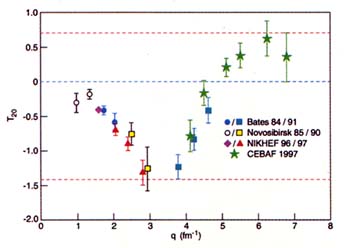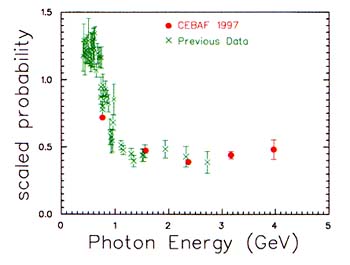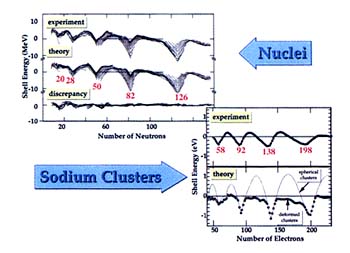3
The Structure of Nuclei

Introduction
The nucleus, the core and center of the atom, is a quantal many-body system governed by the strong interaction. Just as hadrons are composed of quarks and gluons, the nucleus is composed of the most stable of these hadrons—neutrons and protons. The question of how the strong force binds these nucleons together in nuclei is fundamental to the very existence of the universe. A few minutes after the Big Bang, the mutual interactions between nucleons led to the formation of light nuclei. These, and the subsequent nuclear process synthesizing heavier nuclei during stellar evolution and in violent events like supernovae, have been crucial in shaping the world we live in.
One of the central goals of nuclear physics is to come to a basic understanding of the structure and dynamics of nuclei. In approaching this goal, nuclear physicists address a broad range of questions, from the origin of the complex nuclear force to the origin of the elements. Among the key issues still to be resolved are the following:
- How do the interactions between quarks and gluons generate the forces responsible for nuclear binding?
- What is the microscopic structure of nuclei at length scales of the size of the nucleon? Is this structure best understood by including quarks and gluons explicitly in the treatment of nuclei?
- How are the different approximate symmetries that are apparent in nuclear structure related to the underlying interaction and how can they be derived from many-body theory?
- What are the limiting conditions under which nuclei can remain bound, and what new structure features emerge near these limits?
- What is the origin of the naturally occurring elements of our world?
Quantitative answers to these questions are essential to our understanding of nuclei; they also have a potential impact far beyond nuclear structure physics. Probes of short-range structures in nuclei can illuminate the nature of quark confinement, by exposing the extent to which quarks either remain confined to their particular neutrons or protons within nuclear matter or are shared among nucleons as electrons are shared in molecules. As yet poorly understood properties of medium-mass nuclei and of very neutron-rich nuclei critically affect the collapse and explosion of supernovae. In creating the heaviest nuclei in the laboratory, nuclear physicists are extending the periodic table of the elements and revealing deviations from chemical periodicity. Among the new isotopes they have produced in approaching the limits of nuclear stability are ones whose radioactive decay will provide crucial new tests of fundamental symmetry principles.
Progress in all these areas relies on technical advances in theoretical and computational approaches, as well as in accelerator and detector design. For example, investigations of short-range structures in nuclei have been spurred by novel developments in proton accelerators and, especially, by the advent of continuous high-energy electron beams. The role of quarks and gluons in such structures is most likely to be revealed in the lightest nuclei, for which experimental maps can now be compared to essentially exact theoretical calculations based on the picture of interacting nucleons. These calculations have been made possible by adapting the latest quantum Monte Carlo computing methods to the unique aspects of nuclear forces.
On the other hand, it is well known in all branches of physics that a direct approach to the dynamics of complex many-body systems, based on the elementary interactions between their constituents, is not always useful. For example, many properties of heavier nuclei can be accurately described using simpler approximations that retain some, but not all, essential microscopic ingredients. Deep insight into the crucial features of nuclear structure can be gained from an understanding of why such approximations work well, and of where they break down. Particular challenges are to understand the variety of collective motions of nucleons in heavy nuclei, and the fascinating phenomenon of nuclear superconductivity. Significant progress in our understanding of heavy nuclei is expected to come from advances in experimental capabilities.
Another major advance is provided by facilities producing beams of short-lived nuclei. Current understanding of both nuclear structure and nucleosynthesis is largely based on what is known of the properties of stable and long-lived, near-stable nuclei. Between these nuclei and the drip lines, where nuclear binding comes to an end, lies an unexplored landscape containing more than 90
percent of all expected bound nuclear systems, a region where many new nuclear phenomena are anticipated. As is evident from the map of the nuclear terrain in Figure 3.1, the limits of nuclear binding are poorly known at present; often, those limits are close to the regions where the processes that form the elements in stars must proceed.
In the 1996 Long Range Plan, a new experimental facility to explore nuclei near the limits of nuclear binding was identified as the choice for the next major construction project in nuclear science. Recommendation II of the present report is the construction of such a facility. Beams of short-lived nuclei will be produced and accelerated at this facility, and their reactions with target nuclei will be used to synthesize new nuclear species in uncharted territory. By elucidating the properties of these new exotic species, and enabling their use in reactions of astrophysical interest and in tests of fundamental symmetries, this new facility will provide answers to some of the most profound nuclear structure questions identified above.
Nuclear Forces and Simple Nuclei
Measuring various properties of nuclear forces and tracing their origins to the fundamental interactions between quarts and gluons has been one of the major recent goals of nuclear physics. The long-range part of the nuclear force is known to be mediated by pions, the lightest of the mesons. However, our knowledge of the short-range parts is still incomplete. When two nucleons are separated by subfemtometer distances, their internal quark-gluon structures overlap. In such cases, description in terms of the quark-gluon exchange becomes necessary.
The force between two nucleons has been studied extensively over the years by scattering one nucleon from another, and the data have been used to constrain parameters in models of the force. In the past decade, a few successful parameterizations of the low-energy nucleon-nucleon force have emerged; they offer descriptions that differ in their assumptions about short-range behavior. It is an important challenge to experiment and theory to find ways to better understand this aspect of the nuclear force, where the interface with QCD is the most critical. Such information is provided, for instance, in experiments measuring meson production in nucleon-nucleon collisions. In reactions at threshold energies, the two colliding nucleons must come essentially to rest, giving up all of their kinetic energy to produce the meson's mass. The rate of such reactions is sensitive to the strong, short-range parts of nuclear forces. New experiments aim to obtain additional information on pion production by using spin-polarized beams, and to search for the threshold production of heavier mesons. These experiments also probe meson-nucleon interactions at very low energies and provide crucial tests of QCD-based techniques for deriving the effective nucleon-nucleon interaction.
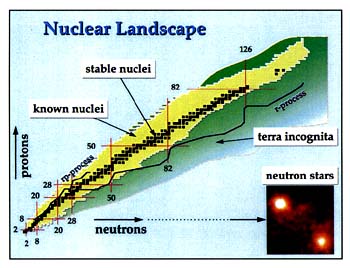
FIGURE 3.1
The bound nuclear systems are shown as a function of the proton number Z (vertical axis) and the neutron number N (horizontal axis). The black squares represent the nuclei that are stable, in the sense that they have survived long enough since their formation in stars to appear on Earth; these form the "valley of stability." The yellow color indicates man-made nuclei that have been produced in laboratories and live a shorter time. By adding either protons or neutrons, one moves away from the valley of stability, finally reaching the drip lines where nuclear binding ends because the forces between neutrons and protons are no longer strong enough to hold these particles together. Many exotic nuclei with very small or very large N/Z ratios are yet to be made and explored: they are indicated by the green color. The proton drip line is established by experiments up to Z = 83. In contrast, the neutron drip line is considerably further from the valley of stability and harder to approach. Except for the lightest nuclei where it has been reached, the position of the neutron drip line is estimated on the basis of nuclear models; it is uncertain due to the large extrapolations involved. Green and purple lines indicate the paths along which nuclei are believed to form in stars; only some of the dominant processes are shown. While these processes often pass near the drip lines, the nuclei decay rapidly within the star into more stable ones. One important exception to this stability plot occurs in extremely massive and compact aggregations of neutrons, neutron stars, under the combined influences of the nuclear forces and gravity.
Unique information on the strong force between hadrons can be obtained by comparing the forces between two nucleons and between a nucleon and a lambda particle in which one of the quarks is a heavier strange quark. Any difference between these forces is entirely due to the change in a single quark. The force between the lambda particle and the nucleon is being mapped with the improved experimental capabilities at CEBAF, as well as through the investigation of bound nuclear systems called hypernuclei, in which a nucleon is replaced by a lambda particle.
Even the best available parameterization of the nucleon-nucleon force cannot accurately explain nuclear binding. In order to reproduce the binding energies of the simplest light nuclei, it is essential to add three-body forces to the pairwise interactions determined from nucleon-nucleon scattering. Such three-nucleon forces are expected because the nucleons are themselves composite objects whose constituents can be distorted by an external force. A more familiar example of such a three-body force is known from the analysis of orbits of artificial satellites. In the Earth-moon satellite system, the tides induced by the moon in oceans in turn alter Earth's pull on the satellite. The nuclear three-body forces are believed to be rather weak, and it has not been possible yet to measure their small effects on the scattering of three nucleons. For now, the strengths of three-body forces have been adjusted to reproduce the binding energies of light nuclei. However, a satisfactory microscopic picture of the three-body force between nucleons is still lacking.
Advances and Challenges in Understanding Light Nuclei
An important ongoing research effort is devoted to measuring various properties of light nuclei having up to eight nucleons. These are the simplest of all nuclei, and the first quantitative comparisons between experimental and theoretical maps of their global and short-range structure have been made. These nuclei are ideal for probing the microscopic aspects of nuclear structure, especially those related to quarks and gluons. The light nuclei also have important roles in astrophysics, elementary particle physics, and energy production. For example, most of the matter in the visible universe is in the form of these light nuclei. The nuclear physics of the Big Bang and of conventional stars like our Sun is primarily governed by the reactions between light nuclei. Nuclear fusion reactors would use some of these reactions as their energy source.
Free neutrons are unstable to radioactive decay. Deuterium (2H) and helium-3 (3He) are the best available surrogates for neutron targets, needed for comparative measurements of the internal structure of neutrons versus protons. A detailed understanding of the structure of these nuclei is necessary for interpreting the results of such experiments.
A direct way to probe the structure of nuclei is again through electron scattering.
|
BOX 3.1 A Microscope to Measure the Distributions of Protons and Neutrons in the Nucleus By bombarding nuclei with electrons from the new generation of electron accelerators and using pairs of spectrometers to detect both the scattered electron and a proton ejected from the nucleus, valuable new insight is gained into how protons and neutrons are distributed in the nucleus. The energies and angles of the electron and proton are measured with the spectrometers, and from this the energy E and the momentum k of the recoiling excited nucleus are deduced. The two-dimensional energy-momentum map yields precision information on the nucleus. As shown in Figure 3.1.1, at small values of E (the so-called valence knockout region, where the recoiling nucleus is in or near its ground state), sharp spikes appear. When E is fixed to be on one of these spikes and the distribution in momentum k is examined, the resulting pattern gives a clear picture of how the least-bound proton orbital is distributed in the nucleus, providing a powerful high-energy electron microscope for studying nuclear structure. At high excitation energies (hundreds of MeV), the picture is much less clear. From work at intermediate energies, it is known that there is a significant probability for such reactions to occur. The violence of these reactions breaks the recoiling nucleus into fragments; theoretical studies lead us to expect that the short-range part of the nuclear force must play a major role in the process. An important goal of experimental and theoretical studies of such (e,e'p) reactions at high energies is to explore this new territory, that is, the highE, high-k part of the excitation map. Studies of (e,e'2p) reactions, where an energetic electron knocks out two protons, offer an additional, promising tool for finding two protons close together inside the nucleus, an excellent measure of the short-range correlations.  |
|
CEBAF was constructed in part with these kinds of studies in mind. It is capable of the required precision measurements and exceeds the capabilities of previous high-intensity accelerators in this energy range by orders of magnitude. CEBAF is now starting to open a fascinating new window for studies at short distance scales. There are additional new knobs to turn in electron-induced studies of nuclear structure. These involve using spin to filter out special features of the reaction. The new generation of electron accelerators all have polarized electron beams, where the spin of the electron is pointed in a direction that is controlled in the experiment. For one of the spectrometers shown in the photograph on the left in Figure 3.1.1, it is possible to measure the direction of the ejected proton's spin; in other cases, the nuclear target may be polarized, having its spin pointed in some specific direction. The control of these spins amounts to having selective knobs at the experimenters' fingertips; in favorable cases, it allows the construction of three-dimensional views of nuclear structure.  FIGURE 3.1.1 Experiments in which electrons knock out protons bound in the nucleus and both are detected in coincidence are being used to probe the distributions of nucleons in the nucleus. The photograph on the left shows an example of the equipment required for these experiments at high energies—the high-resolution spectrometers used in Hall A at CEBAF. On the right, results from previous studies with intermediate energy electrons are shown. (Courtesy Thomas Jefferson National Accelerator Facility.) |
The essentially structureless electron, possessing both an electric charge and a magnetic moment, is used as a probe to map the distribution of charge and magnetism within the nucleus. As the energy of the electrons is raised, the quantum mechanical wavelength of the electron is reduced and the resolution of the maps increases.
High-energy electrons are also used to knock out the constituents of nuclei and gain valuable information. For example, by detecting the knocked-out proton or neutron along with the scattered electron, one can assess the momentum and energy distribution of nucleons in the nucleus. In particular, the data at especially large values of nucleon momenta provide crucial information on the strong forces at short distances. New insights can also be obtained by knocking out mesons from nuclei. Under certain kinematic conditions the electron can penetrate deeply within a nucleus, striking one of the virtual pions or heavier mesons being exchanged between nucleons and making it detectable.
Of particular importance to these measurements are the recently developed continuous electron beams. Previously, electron beams were largely delivered in short bursts containing many electrons. In a single burst of the beam, many particles are produced by interaction of different electrons with different target nuclei. When it is necessary to detect more than one particle produced from a single electron-nucleus interaction, the background produced in a burst often swamps signals of interest. With a continuous beam, the background can be dramatically reduced, resulting in clear identification of the desired signal (see Box 3.1).
The new experimental effort to probe light nuclei aims to fully utilize the capabilities of the recently completed continuous-beam electron accelerators and large-acceptance detectors. The ground states of most light nuclei have a nonzero spin, and many experiments propose to use spin-polarized targets to obtain three-dimensional maps of their structure. Measurements over the next 5 to 10 years will provide a detailed picture of the quantum-mechanical wave functions of two-and three-nucleon systems. Key goals are to get a quantitative measure of the small components in the wave function to pin down the role of quarks in hadrons other than nucleons and the distribution of high-momentum nucleons.
On the theoretical side, due to recent progress in computational techniques used in nuclear physics, all the bound states of these light nuclei can now be calculated, essentially exactly, from realistic nuclear forces that can interchange protons and neutrons and may flip their spins. In particular, quantum Monte Carlo methods have been adapted to study nuclei, using massively parallel computing platforms. The method is being extended to take into account leading relativistic effects in nuclear structure.
Correlations (e.g., how the separations between nucleons are distributed in nuclei) are strongly influenced by the nature of nuclear forces. Present calculations predict that neutron-proton pairs in nuclei have substantial probability to form intricate structures of toroidal (doughnut-like) and dumbbell shapes of
femtometer size, as small as a single isolated nucleon. Such shapes are formed by the joint action of the short-range repulsive force and the anisotropic pion-exchange force between nucleons. A clear view of these structures can be obtained in the only nucleus with just two nucleons, the deuteron. When the deuteron is spin-polarized in one of its three possible quantum states, it has a toroidal shape; in the other two states, it resembles a dumbbell, as illustrated in Box 3.2.
The difference between the distribution of electric charge within the different deuteron spin-states has been measured only in recent years. The measurements confirm that the density in the toroidal distribution peaks at the predicted radius of about half a femtometer, making the deuteron the smallest ring-type structure known. Similar experiments being carried out at higher energies will probe the thickness of this toroidal distribution. Since the two nucleons forming the dense part of the toroidal structure are so close, their quark substructures probably overlap. Indeed, the results of another early experiment at the TJNAF indicate such an overlap.
The scattering of electrons by nuclei also provides information about the carriers of the nuclear force. This is possible because the nuclear force is mediated in part by the exchange of charged mesons, which results in a so-called exchange current contribution to the total electric current in a nucleus. In contrast, there is no comparable contribution to the electric current in an atom, because the electromagnetic force that binds electrons to nuclei is mediated by the exchange of electrically neutral photons. Important exchange current contributions have been revealed, for example, in beta decay, in the disintegration of deuterons by energetic electrons, and in the elastic scattering of high-energy electrons from 2H and 3He nuclei, but a comprehensive understanding of the quantitative basis of this exchange current in terms of QCD waits upon data from the new facilities.
Significant advances have been made in methods used to compute rates of reactions involving three and four nucleons from realistic models of nuclear forces. One example is the extension of exact calculations for nucleon-deuteron reactions; at higher energies, the dynamical effects of three-nucleon forces on reaction processes may become accessible to experimental delineation for the first time. A second example is that of low-energy fusion reactions in which two light nuclei fuse, with the excess energy radiated away in the form of photons. New experiments are being carried out to study these processes at very low energy with spin-polarized beams of protons and deuterons. Progress in understanding these reactions is relevant for related fusion processes in the Sun, affected by the weak, rather than the electromagnetic, interaction. These weak capture reactions contribute significantly to energy production at solar temperatures and densities, but they occur at too low a rate to be studied directly in the laboratory.
|
BOX 3.2 Measuring the Shape of the Deuteron The deuteron, with just one proton and one neutron, is the simplest of nuclei beyond the proton. The nucleon density distribution in the deuteron, illustrated in Figure 3.2.1, is determined by nuclear forces; the density is large where the forces are attractive, and small where they are repulsive. It is different for the deuteron states with different spin projection because the pion exchange forces depend upon the nucleon spin orientations. The dumbbell-shaped distribution in the state with spin projection ± 1 is formed by rotating the toroidal distribution in the spin projection zero state. These basic properties of the deuteron can be measured with a conceptually simple but technologically demanding experiment. Deuterons are bombarded with high-energy electrons, and the spin projection of the struck deuterons along the direction of their recoil is measured. Apart from small corrections, when the quantum wavelength of the recoiling deuterons is twice the diameter of the doughnut, the recoiling deuterons have only zero spin projection, and the anisotropy shown in Figure 3.2.2 has its minimum possible value of -1.4. The measured value of this wavelength then is a clear signal that the radius of the torus in the core of the deuteron is about half a femtometer. These experiments, initiated in 1984, require high-intensity, high-energy electron beams. The most recent data, taken with 4-GeV electrons, correspond to wavelengths of about one femtometer. In this region one expects to observe maximum anisotropy when the wavelength becomes equal to the thickness of the toroidal distribution. When the nucleons are in the densest part of the deuteron, their quark structures overlap. The effect of this overlap can be seen in the cross section for disintegrating the deuteron with a high-energy photon. There are two possible processes. In the nucleon process, three strongly interacting quarks within one nucleon absorb the photon's energy. This energetic nucleon then collides against the other, causing the deuteron to break up. In the quark process, which can only occur when the quarks in the two nucleons overlap in space, the photon's energy is absorbed by all of the six strongly interacting quarks, which break apart into two energetic nucleons. The observed cross section shown in Figure 3.2.3 has been scaled such that the quantity plotted is flat for the quark process. It appears that 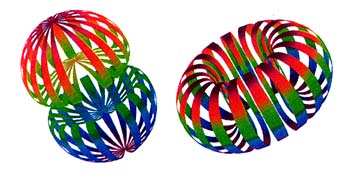 FIGURE 3.2.1 Theoretical predictions of surfaces of equal density in the deuteron in states with the projection of the spin being either one or zero along the symmetry axis. The surfaces shown are for half the maximum density of the deuteron. |
Nuclear Forces and Complex Nuclei
The work on few-body nuclei discussed above demonstrates that there is a phenomenological theory for nuclear physics: an interaction derived from nucleon-nucleon scattering, augmented by a weaker three-body force, that is used to predict the properties of the lightest nuclei with present-day computing capabilities. Thus, even though the fundamental constituents of nuclei are quarks and gluons, there exists a simpler effective theory that accurately describes nuclei in our everyday world.
One important issue facing the field is to understand the relationship between this effective theory and QCD: Why does a model in which nucleons are interacting through a potential provide such a good approximation to the behavior of quarks and gluons in nuclei? Another question is how to extend this success in the lightest nuclei to heavier systems.
The fundamental difficulty is a numerical one: no existing computer is sufficiently fast to solve the quantum mechanics of interacting nucleons when the number of nucleons becomes large. Moreover, a complete solution of over a hundred interacting nucleons would be so complex that additional insights would be needed to interpret it and bring out its important features. Thus, physicists often must find alternatives to a direct approach to the complex many-body problem.
The Shell Model of Nuclei
The conceptual framework for heavier nuclei is the shell model, in which each nucleon is assumed to move in an average potential generated by its interactions with all of the other nucleons in that nucleus. This potential, or mean field, leads to the prediction that the quantum levels in a nucleus form shells within which several nucleons can reside. This mean field picture of nucleon motion within the nucleus explains a host of phenomena: the existence of particularly stable “magic" nuclei corresponding to completely filled shells, the low-lying excitations of such nuclei, and the collective responses of nuclei in the absorption of photons and other excitations. Maria Goeppert-Mayer and J.H.D. Jensen received the Nobel Prize for their pioneering work on introducing the concept of a shell model in the context of the nucleus.
The shell model's mean field was a significant success, and the model was soon developed further to include the residual part of the nucleon-nucleon interaction that could not be absorbed into the mean field. Theorists found that by solving the model problem of nucleons in several shells interacting through the residual interaction, a mapping (a one-to-one correspondence) emerged between the resulting shell model states and the energy levels measured in nuclei. Many properties of the actual states, especially when the nucleus is probed at appropriately long wavelengths, were found to match closely those of the corresponding shell model states.
The accuracy of this correspondence—the extent to which nucleons in a real nucleus appear to move in an average nuclear potential—is being addressed experimentally. In a series of measurements performed in the past decade, high-energy electrons were used to knock out single protons from nuclei as described in Box 3.1. For the magic nuclei in which both the protons and neutrons completely fill shells, the probability for this knockout process was found to be about two-thirds of that predicted by the simplest shell model picture, suggesting that nucleons indeed spend most of their time moving in shell-model-like orbits. The remaining one-third of the strength presumably corresponds to nucleons moving at high momentum in the nucleus and not directly included in the shell model. This occurs when nucleons pass close to one another and can feel their mutual strong interaction. One important role for CEBAF is measurement of the energy-momentum distribution of nucleons when they are not in their shell model orbitals. Such measurements will allow experimenters to see the effects of nucleon-nucleon interactions within a nucleus. The nature of these short-range interactions will also be revealed through the correlated pairs of nucleons that are occasionally knocked out of the nucleus.
Although the shell model simplifies the nuclear many-body problem, the resulting calculations are still quite daunting. When nucleons are distributed over several valence shells, the number of shell model configurations that intermingle through the residual force becomes quite large. Realistic calculations for nuclei lighter than 40Ca have been feasible for some time. Even though the algorithms have been improved and the speed of computers is steadily increasing, this has produced only a modest advance, extending the calculations to A ![]() 50.
50.
One important recent advance in the shell model is helping to circumvent this problem. An alternative to conventional calculations has been provided by the quantum Monte Carlo techniques. While the method involves some approximations, it has been shown to reproduce accurately the results of exact, conventional shell model calculations. But unlike conventional techniques, it can be extended to heavier nuclei, where the number of configurations is enormous. One notable success of the Monte Carlo shell model is in calculating spin-flip responses in nuclei in the iron region that controls the critical rate of electron capture in the collapse of a supernova.
Another exciting direction for research involves the possibility that the shell model could become a much more quantitative many-body technique. It has been known for some years that a rigorous connection exists between the shell model and exact many-body theory. Because the connection was computationally difficult to make, the model became heavily phenomenological. But with recent advances in computing power, it now appears that those pieces of the many-body problem that are missing from the shell model—corresponding to the short-range interactions described above—can be put back in a systematic way. Results from exact calculations in light nuclei suggest that this goal might be within reach.
Mean Field Methods
Despite the exciting progress in shell model approaches, applications to heavy nuclei are still beyond our reach. These systems show a variety of collective motions, such as vibrations and rotations, involving many nucleons. A. Bohr, B. Mottelson, and J. Rainwater received the Nobel Prize for developing the nuclear unified model, which is capable of describing nuclear collectivity in terms of individually moving nucleons. But just as exact techniques in the lightest nuclei provide a bridge to the intermediate mass nuclei studied in the shell model, the shell model provides another bridge to the heavy nuclei, where other techniques are used. The effective interaction derived in shell model studies can be employed in mean-field studies of heavy nuclei. Studies based on the mean-field approach, preserving the self-consistency between the shape of the average potential and the geometry of the nucleonic orbits in it, have enjoyed remarkable success in predicting the masses, shapes, excitations, and decays of complex nuclei. The properties of this optimal average potential, such as its range and its shape (which often is not spherical), strongly depend on the number of nucleons. The effective interactions in complex nuclei are responsible for a variety of collective phenomena involving many nucleons. For instance, pairing between nucleons is responsible for the phenomenon of nuclear superconductivity, analogous to superconductivity of materials. Pairing has significant influence on nuclear dynamics, and innovative techniques have been developed to include its effects. Experimental tests of the models for complex nuclei come from low-energy facilities employing a variety of techniques.
Only recently, it has become possible to incorporate relativistic effects into the mean field description. A critical ingredient of the average potential needed to account for the observed magic numbers has been the so-called spin-orbit interaction, a force dependent on the direction of the nucleon's intrinsic spin relative to the sense of its orbital motion. The physical origin of the large spin-orbit force that is needed has been a mystery, given what is known about forces between two nucleons in free space. However, in the relativistic treatment of this problem, the magnitude of the spin-orbit interaction's strength is explained naturally.
In addition to the systematic approaches discussed above, a variety of phenomenological models of complex nuclei exist that give insight into many aspects of nuclear dynamics, such as collective rotations and vibrations. The philosophy is one familiar in other subfields, such as condensed-matter physics, where once the appropriate collective degrees of freedom are recognized, great simplicity often emerges from complex systems. Insight of this sort can be gained only by careful experimentation. Much of the rest of this chapter deals with efforts to gain such insight by examining nuclei at the extremes of mass, angular momentum, and ratio of neutrons to protons.
Limits of Nuclear Stability
One of the themes of today's nuclear science is the journey to the limits in several directions. For nuclear charge and mass this journey involves nuclei heavier than any that occur in nature or that have been produced in the laboratory; for the neutron-to-proton ratio, it involves the drip lines, the limit of binding; and for angular momentum, the journey involves the extremes of rapid rotation. Exploring the limits is expected to bring qualitatively new information about the fundamental properties of the nucleonic many-body system, about astrophysical processes and the origin of elements, and about fundamental symmetries. New, unexpected phenomena may be discovered.
The Quest for Superheavy Elements
Nuclear science started a century ago when Becquerel and the Curies discovered that not all the nuclei of atoms were stable (in other words, the phenomenon of radioactivity). This laid the foundation of nuclear chemistry and physics, and changed the face of science, technology, and medicine. The modern periodic table (as of 1998) ends with the 112th element, which was recently discovered. But the search for new elements is still an active field, and we may be due for another expansion at the upper end of the periodic table, shown in Figure 3.2.
The discovery of the properties of a brand-new set of chemical elements can answer questions of fundamental importance for science. What are the maximum charge and mass that a nucleus may attain? What are the proton and neutron magic numbers of the new elements? Where are the closed electron shells, and what are the chemical properties of such atoms of new elements?
The elements occurring naturally in the composition of Earth extend up to uranium, whose nucleus has 92 protons, but heavier elements have been synthesized in the laboratory. Like uranium, they are unstable; their absence in nature is due to their short life, as compared to the time since the heavy elements were formed in an explosive stellar event. The lifetime of uranium is long on this scale, comparable to Earth's age. Nuclei with atomic number Z > 104 would fission instantaneously if they were charged liquid drops governed by classical mechanics. However, the nucleus is a quantal system, and the stabilizing effects of shells allow nuclei of heavier elements to exist for a sufficiently long time that we can study their properties. According to nuclear models, there exists an entirely new group of superheavy elements, with charges around Z = 114 to 126, that are strongly stabilized by the shell effects. The first theoretical predictions of the island of superheavy elements came in the mid-1960s, and great effort is being made at several leading facilities to reach it. The heaviest element made and identified so far has Z = 112. The synthesis of that element required weeks of effort to produce a single atom.
All the heaviest elements found recently decay predominantly via alpha-
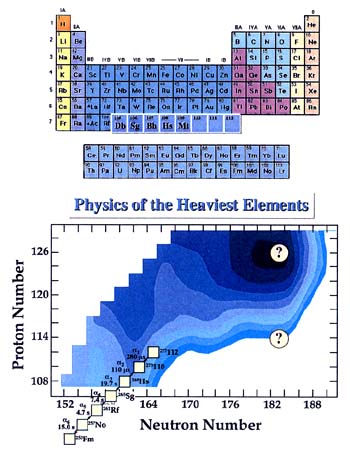
FIGURE 3.2
Top: Mendeleev's periodic table of the elements as of 1998. It includes the heaviest elements synthesized by mankind: rutherfordium, dubnium, seaborgium, bohrium, hassium, meitnerium, and the recently synthesized elements 110, 111, and 112, which are yet to be named. The chemical properties of the heaviest elements have been investigated up to nuclei as heavy as seaborgium. The strong relativistic effects cause deviations from the periodicity of chemical properties that characterizes the periodic table for lighter elements. Indeed, examples of such chemical deviations have already been observed for the elements rutherfordium and dubnium, whose properties differ from trends observed for the lighter members of their chemical families.
Bottom: Contour map of the calculated energy gain from the formation of shells in the structure of the nucleus. According to theoretical models, the region of the transactinide nuclei is connected with the region of superheavy shell stability through the valley of deformed nuclei around N = 164 and Z = 110. The experimental chain of alpha-particle decays that identifies the heaviest known element as Z = 112 and N = 165 goes through this valley. Where is the center of superheavy shell stability expected to fall? For the neutrons, most calculations predict an increased stability at N = 184. However, because of differing treatments of the strong Coulomb force and the spin-orbit interaction, theorists are not unanimous with regard to the position of the magic proton number. While earlier calculations yielded the value Z = 114, modern models, such as the one presented in this figure, favor Z = 126 or Z = 120. Both these scenarios are indicated by question marks.
radioactivity—the emission of helium-4 nuclei—just as do the naturally occurring uranium isotopes and the lighter transuranic elements. The chain of alpha particle decays that identifies the heaviest known element as A = 277 and Z = 112 is shown in Figure 3.2. The precisely measured energies of the emitted alpha particles allow the reconstruction of the mass of the new heavy parent nucleus.
The experimental quest to synthesize nuclei with Z < 112 and N ~ 184 will not be easy, given the observed trend of decreasing yields from fusing two lighter nuclei into a heavy one. However, the superheavy nuclei are expected to live longer than the most recently synthesized elements. The long-term optimism is based on the prospects of building or upgrading facilities to produce intense beams, including beams of radioactive neutron-rich nuclei which, in combination with neutron-rich targets, may provide a path leading to the predicted superheavy elements. Experiments will almost certainly require significant advances in isotope separation and detection technology. But if they succeed in producing shell-stabilized, spherical superheavy nuclei, they will represent a major scientific triumph.
The discovery of superheavy elements would also provide crucial information on relativistic effects in atomic physics and quantum chemistry. According to calculations that include a correct treatment of special relativity, the velocity of the inner-shell electrons is predicted to approach the velocity of light as the atomic number of a nucleus approaches 173. The resulting relativistic effects
cause deviations from the periodicity of chemical properties that characterizes the periodic table for lighter elements.
Toward the Limits in Neutron-to-Proton Ratio
Fewer than 300 stable isotopes, shown by black squares in Figure 3.1, occur naturally. These are the combinations of neutrons and protons that are the most stable and do not decay by the emission of radiation. In the remaining nuclei, the ratio of neutrons to protons is less optimal than in neighboring combinations, and so these nuclei decay to their more stable neighbors through weak interactions. These interactions change neutrons into protons or protons into neutrons to reach the most stable value of N/Z for a given total number of nucleons. The uncharted regions of the N-Z plane can answer many questions of fundamental importance for science: How many neutrons can be bound to a nucleus? What are the unique properties of the very short-lived nuclei having extreme values of N/Z? What are the properties of the effective nucleon-nucleon interaction in an environment different from that encountered in stable nuclei?
The developments in technology have been keeping up with the increased difficulties in synthesizing nuclei farther and father away from stability. In the past several years, new nuclei having unusual N/Z ratios have been produced and identified. But a great deal of development remains to meet the major goal of extending nuclear structure studies out to the drip lines, where no additional protons or neutrons will be bound. The proton drip line lies relatively close to the valley of stability, hence it is easy to reach experimentally. However, because neutrons do not electrically repel one another, many of them can be added to stable nuclei before no more will be bound. The neutron drip line is therefore far from the valley of stability and its location is very uncertain, as indicated in Figure 3.1.
Unlike the processes in supernova explosions of stars, there are no direct flights to the nucleon drip lines in the laboratory by utilizing the stable or near-stable nuclei that have traditionally been available as beams and targets. Rather, one must proceed in two stages: first, conventional nuclear reactions produce radioactive species that are collected to form a secondary beam, and then that is used for the subsequent jump into the unknown region. Substantial advances in accelerator, ion source, and mass separator technology over the past twenty years have contributed greatly to the technology required to produce beams of short-lived nuclei. At present, there are only a few laboratories with only a very limited set of such capabilities. However, the success of the current programs and the interest in the new physics that they make accessible has led to developments and proposals for a new generation of such facilities worldwide.
The interest in the experimental exploration of the neutron-drip-line region is driven not only by the substantial uncertainties in its location, but also by the expectation that qualitatively new features of nuclear structure will be discovered
in this exotic territory. Such features are expected for nuclei that contain a sizable number of very weakly bound neutrons. This condition should lead, for example, to a diffuse nuclear surface, in which superconducting correlations play an enhanced role.
Just before the neutron drip line, neutrons occupy orbits outside the nuclear core that are spatially extended and, from Heisenberg's uncertainty principle, have low momentum. These states, called halos, have radii that are up to several times that of the core, as is illustrated in Figure 3.3. In the limit of extremely small binding energy for a pair of neutrons to a core nucleus, giant halos will be encountered, with radii an order of magnitude larger than that of any stable nucleus.
In the surface region of heavier, very neutron-rich nuclei, one may find nearly pure neutron matter at densities much less than the normal nuclear density. The weak binding and strong pairing between surface neutrons could substantially wash out the nuclear shell structure as one approaches the neutron drip line. The concept of magic nuclei may even disappear completely in the neutron-rich extremes of the nuclear world; a possible first indication of this in the abundance of the isotopes of elements is shown in Figure 3.4. The weakening of shell structure would have a significant effect on the location of the drip line, and on the way the elements form in the neutron-rich environment of supernovae.
Improvements in the availability and intensity of radioactive nuclear beams will also greatly facilitate the study of proton-rich nuclei. Of particular interest are nuclei in the neighborhood of the N = Z line (i.e., systems with nearly the same proton and neutron numbers). It is precisely in such nuclei that the fastest and best understood nuclear beta-decay processes occur. The rates of these decay processes provide stringent tests of fundamental symmetries.
The well-known phenomenon of superconductivity in solids arises from the interaction between electrons to produce correlated (Cooper) pairs. The attraction responsible for this pairing results from the interaction of the electrons with the lattice of ions in the solid. The phenomenon of superfluidity (involving superconductivity) of nuclei originates similarly from interactions between pairs of nucleons. To date, the superconducting phases associated with Cooper pairs of like nucleons—two neutrons and two protons—have been found. Heavier N ![]() Z nuclei may also reveal a new form of nuclear correlation from proton-neutron Cooper pairs having a unit spin like that of the deuteron.
Z nuclei may also reveal a new form of nuclear correlation from proton-neutron Cooper pairs having a unit spin like that of the deuteron.
Proton-rich nuclei offer the unique opportunity to study the nuclear system beyond the drip line. Although the protons in this region are not bound, their escape is delayed by an almost counterintuitive consequence of the repulsive Coulomb force. In these nuclei, the proton can leave the nucleus thanks to a process called quantum tunneling. In favorable cases, the tunneling of a correlated pair of protons is expected. Pioneering studies of proton emitters are already being carried out at several facilities, using stable beams and advanced detection systems.
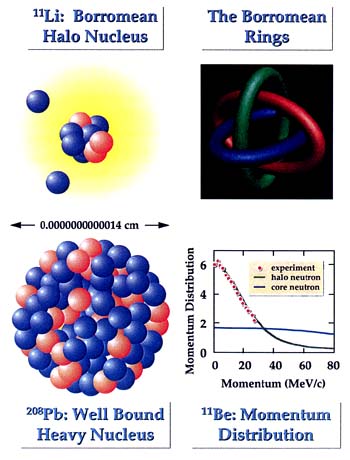
FIGURE 3.3
Loosely bound halo nuclei such as lithium-11 and beryllium-11 are unique few-body systems. A paradigm of the unexpected phenomena and unusual topologies that may occur in the vicinity of the neutron drip line is the nucleus 11Li (3 protons and 8 neutrons), understood as a three-body halo consisting of two neutrons and a well-bound 9Li core. Interestingly, while all three constituents of 11Li form a bound system when placed together, the nuclear potential is not strong enough to bind any two of them separately; hence, the name borromean nuclei. (This name comes from the Borromeo family of Renaissance Italy, whose family coat of arms pictured three rings interlocking in such a way that removing any one ring would cause all three to fall apart). Because of very weak binding, the last neutrons in lithium-11 occupy the same volume of space as the 208 nucleons in lead. Bound neutrons are not permitted to go far away from the nuclear core, by classical laws of motion; the halo structure occurs by grace of quantum mechanics. The existence of halo structure in beryllium-11 has been deduced experimentally at the Michigan State University National Superconducting Cyclotron Laboratory by studying the momentum distribution of the most weakly bound neutron (shown in the lower right of the figure). Compared to that for the well-bound neutron belonging to the beryllium-10 core, this distribution is exceptionally narrow, as expected from the Heisenberg uncertainty principle for a particle occupying an extended volume in space.
While most of our knowledge of nuclei is limited to the neighborhood of the valley of stability, early experiments on far unstable nuclei have already revealed surprises. New phenomena such as halo nuclei—with regions of nearly pure neutron matter—and growing evidence of the fragility of shell structure far from the valley of stability are just two examples. It is becoming increasingly clear that some of the cherished concepts of nuclear structure may apply only to the set of relatively stable nuclei. The advent of radioactive ion beams offers a tool to attack the basic questions pertaining to the behavior of nucleonic matter—its binding, its dynamics, and its phases.
Limits of Angular Momentum
In spite of the fact that the number of nucleons in the nucleus is rather small, and nucleonic velocities are fast, protons and neutrons can organize themselves into states exhibiting collective motion, such as rotations or vibrations. Nuclear collective rotation is uniquely interesting due to the presence of both shell structure and superconductivity.
Many nuclei emit photons characteristic of the sequential de-excitation of excited states within rotational bands. The energy levels within such a band appear to share a common intrinsic distribution of nucleons, but differ from one another in having different degrees of collective rotation. In quantum mechanics, such collective rotation can arise for systems that have a deformed shape; the characteristics of the photons emitted by the rotating nucleus provide insight into the shape and structure of nuclei, as illustrated in Figure 3.5. Some of the exciting recent discoveries in nuclear structure are associated with such rotational
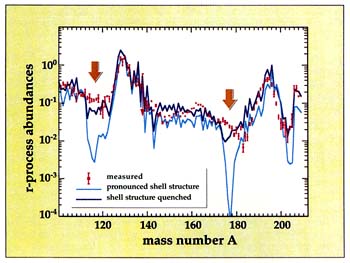
FIGURE 3.4
The structure of nuclei is expected to change significantly as the limit of nuclear stability is approached in neutron excess. Both the systematic variation in the shell model potential and the increased role of superconducting correlations give rise, theoretically, to the quenched neutron shell structure, characterized by a more uniform distribution of levels with dramatically reduced shell gaps. An important aspect of this shell quenching is its influence on astrophysical processes and on stellar nucleosynthesis. Very neutron-rich nuclei cannot be reached experimentally under present laboratory conditions. On the other hand, these systems are the building blocks of the astrophysical process of rapid neutron capture (the r-process, see Chapter 5); their separation energies, decay rates, and neutron capture cross sections are the basic quantities determining the elemental and isotopic abundances in nature. Consequently, one can actually hope to learn about properties of very neutron-rich systems by inverting the problem and studying the r-process component of the solar system abundances of heavy elements. The black squares with error bars indicate the observed r-process abundances for nuclei with mass numbers greater than A = 100. The theoretical abundances, marked by red and blue, were obtained in the recent r-process network calculations. They are based on models that assume that the spherical shell effects towards the neutron drip line are either similar to those in stable nuclei (red curve) or significantly reduced (blue curve). It is seen that a quenching of magic gaps at N = 82 and N = 126 can lead to a dramatic increase in the calculated abundances of nuclei around A = 118 and 176, in better agreement with the data. (Adapted from Bernd Pfeiffer et al., Zeitschrift für Physik A357, 253, 1997.)
bands indicating very elongated, superdeformed shapes having the longer axis twice as long as the shorter (see Box 3.3). This simple 2:1 ratio gives rise to a set of magic numbers that are different from those in spherical nuclei, and their existence is necessary for the stability of the observed superdeformed states. There is an ongoing search for even more deformed, hyperdeformed states with a 3:1 axis ratio, which are expected at the largest spins (just before the nucleus breaks up).
In a state of a very high angular momentum, the nucleus behaves like a solid in a strong magnetic field. Hence, many magnetic phenomena may occur, similar to effects already known from condensed-matter physics. One of the main challenges for the theory of rotating nuclei is to understand the nature of the dramatic spin polarization induced by fast rotation.
The spacing of energy levels in a nucleus changes from the regular, widely spaced pattern near the ground state to the more dense and random or chaotic pattern higher up. Gamma-ray spectroscopy with the new generation of detector systems, such as Gammasphere, is a unique probe of quantum chaos, roughly defined as a regime where the pattern of quantum numbers that may be used to characterize low-lying states of a many-body system is gone. Here, the important issues under study are these: At what energy does chaos set in? What are the unique fingerprints of the transition from regular to chaotic motion? The signatures for the onset of chaos are observed not only in the distribution of energy levels, but also in the properties of electromagnetic transition intensities.
The increased precision of spectroscopic tools has allowed nuclear physicists to unveil some subtle, but startling, new phenomena:
- Identical Bands. Identical sequences of ten or more photons are observed, associated with rotational bands in different nuclei. This comes as a great surprise: it has long been believed that the gamma-ray emission spectrum for a specific nucleus represents a unique fingerprint. Explanation of these identical patterns in a wide variety of nuclei is still lacking.
- Magnetic Rotation. In nearly spherical nuclei, sequences of gamma rays are reminiscent of collective rotational bands, but with a quite different character: namely, each photon carries off only one unit of angular momentum and couples to the magnetic, rather than electric, properties of the nucleons. This is a new form of quantal rotor.
- ΔI = 4 Bifurcation. Extremely small but regular fluctuations are seen in the energies of photons emitted from some superdeformed nuclei. They could be driven by quantum tunneling motion at high angular momentum.
- Band Termination. Large rotational velocities can induce a gradual shape transition from the deformed state, which can rotate to the nearly spherical configuration incapable of rotational motion. Such a “death of the rotational band" has been seen in a number of nuclei.
- Nuclear Meissner Effect. Quenching, a total disappearance of nuclear
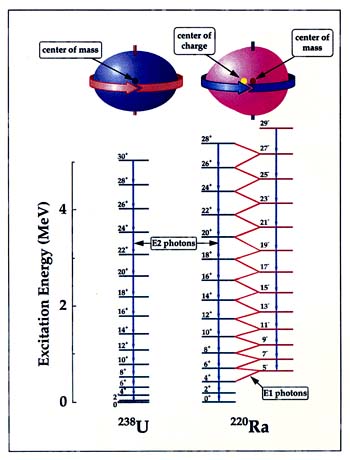
FIGURE 3.5
The existence of nuclei with stable deformed shapes was known early in the history of nuclear physics. The observation of large quadrupole moments led to the suggestion that some nuclei might have spheroidal shapes, which was confirmed by observing rotational band structures and measurements of their properties. For most deformed nuclei, such as 238U, a description as an elongated sphere (i.e., a spheroid) is adequate to describe the band's spectroscopy. Because such a shape is symmetric, all members of the rotational band will have the same parity. However, it has since been found that some nuclei might have a shape more like that of a pear, which is asymmetric under reflection. The rotational band of 220Ra consists of levels of both parities, hence the name parity doublet. Another signature of such a parity doublet is the enhanced electric-dipole radiation in 220Ra due to a nonzero electric-dipole moment. Advances in high-resolution, gamma-ray detector systems are also responsible for a revolution in our study of low-spin nuclear behavior. Here, new insights have been gained on the nature of collective nuclear vibrations. In particular, vibrational multiphonon states long searched for were found experimentally. The existence of these new collective modes, both at low and high frequencies, is intimately connected with the effects of the Pauli exclusion principle.
- superconductivity, is observed at high rotational frequencies. The angular momentum behaves like an external magnetic field: it tries to align the angular momenta of nucleons along the axis of rotation, and this destroys Cooper pairs of nucleons responsible for superconductivity.
- Symmetry Scars. These highly excited states, such as those in a superdeformed band, represent order in chaos. The motion in these states is ordered (i.e., it is well characterized by a number of quantum numbers). The symmetry scars are embedded in the sea of many other states that can be described in terms of chaotic motion.
Advances in high-resolution, gamma-ray detector systems are also responsible for a revolution in our studies of low-spin nuclear behavior carried out at low-energy accelerators. Here, new insights have been gained into the long unresolved, but basic, questions about the mechanisms of nuclear vibrations, about nuclear superconductivity, the statistical properties of excited nuclei, and the approximate symmetries of the many-body system. For instance, long-searched-for, vibrational multiphonon states have been discovered. The very existence of these new collective modes of nuclei, both at low and high frequencies, is intimately connected with the effects of the Pauli exclusion principle. In nuclei, nature displays the enormous diversity found in the behavior of many-body systems (see Box 3.4). Exploring this diversity in experiments, discovering its new facets, and finding effective theoretical approaches to account for them remains a continuing challenge.
|
BOX 3.3 The Champion of Fast Rotation Rotation is a common phenomenon in nature—most objects in the universe, from the very small to the very large, rotate (Figure 3.3.1). The largest and slowest rotors are galaxy clusters. The rotation of the Andromeda Galaxy, the nearest major galaxy to our Milky Way, can be inferred from its giant spiral-shaped disk containing some hundred billion stars. Saturn is an excellent example of a deformed oblate (flattened sphere) rotator; its shape deformation is caused by a large centrifugal force. Among stellar bodies, pulsars are by far the fastest rotors: the Crab pulsar makes one revolution every 0.033 seconds! Among the dizziest mechanical man-made objects are ultracentrifuges used for isotope separation. With some modifications, the concept of rotation can be applied to small microscopic systems, such as molecules, nuclei, and even hadrons, viewed as quark-gluon systems. Atomic nuclei, with their typical dimensions of several femtometers and rotation periods ranging from 10-20 to 10-21 sec, are among the giddiest systems in nature. What makes the nuclear rotation special and interesting are quantal effects due to the nuclear shell structure and superconducting correlations. Most rotating celestial bodies show a common behavior: at low angular momenta they acquire axial shapes depressed at the poles, like our Earth or Saturn, but at sufficiently rapid rotation, a shape transition to ellipsoidal forms having three different axes takes place. At even faster rotations, the body becomes so elongated 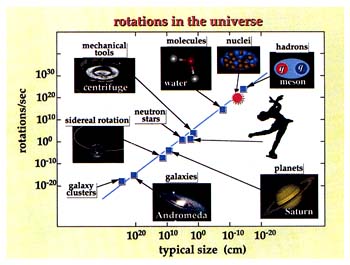 FIGURE 3.3.1 |
|
that it fissions into two fragments. Interestingly, the shape changes found in hot nuclei, where the shell effects and superconductivity can be ignored, seem to resemble this behavior. The best nuclear rotators have elongated shapes resembling a football. The signature for such superdeformed states is a "picket fence" spectrum of gamma rays. The experimental spectrum of superdeformed 150Gd shown in the upper part of Figure 3.3.2 was obtained in 1989 in England. The bottom, much improved, spectrum was taken at the Lawrence Berkeley National Laboratory using the new-generation germanium-array Gammasphere with 55 detectors. The increased precision of experimental tools of gamma-ray spectroscopy has made it possible to probe new effects on the scale of a 1/100,000 of the transition energies. 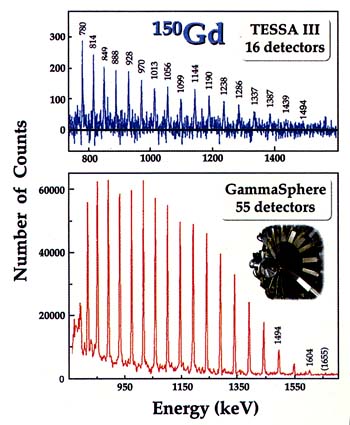 FIGURE 3.3.2 |
|
BOX 3.4 The Nucleus: A Finite Many-Body System While the number of degrees of freedom in heavy nuclei is large, it is still very small compared to the number of electrons in a solid or atoms in a mole of gas, and as such the nucleus presents one of the most challenging many-body problems. Many fundamental concepts and tools of nuclear theory, such as the treatment of nuclear superconductivity and of nuclear collective modes, were brought to nuclear physics from other fields. Today, because of its wide arsenal of methods, nuclear theory contributes significantly to the interdisciplinary field of finite many-body systems. From Nuclei to Molecules, Clusters, and Solids: Shells and Collective Phenomena The existence of shells and magic numbers is a consequence of independent particle motion. The way the energy bunching of this shell structure occurs depends on the form and the shape of the average potential in which particles are moving. The electromagnetic force acting on electrons in an atom is different from the force acting between nucleons in a nucleus; this is why atoms and nuclei have different magic numbers. Small clusters of metal atoms (typically made up of thousands of atoms or fewer) represent an intermediate form of matter between molecules and bulk systems. Such clusters have recently received much attention—not least because of their striking similarity to nuclei. When the first experimental data on the structure of such clusters was obtained, it was immediately realized that the shell-model description could be applied to valence electrons in clusters. The nuclear shell energy and the shell energy for small sodium clusters are shown in Figure 3.4.1. In both cases, the same technique of extracting the shell correction has been used. The sharp minima in the shell energy correspond to the shell gaps. Nuclei and clusters that do not have all their shells fully occupied have nonspherical shapes. In Figure 3.4.1, the deformation effect is manifested through the reduction of the shell energy for particle numbers that lie between magic numbers. The deformation of the clusters can be deduced by studying a collective vibration that is a direct analog of the nuclear giant dipole resonance. As in nuclei, the occurrence of the deformation of the cluster implies that the dipole frequency will be split. This and many other properties of metallic clusters have been initially predicted by nuclear theorists, and their existence has been subsequently confirmed experimentally. Interacting electrons moving on a thin surface under the influence of a strong magnetic field exhibit unusual collective behavior known as the fractional quantum Hall effect. At special densities, the electron gas condenses into a remarkable state, an incompressible liquid, while the resistance of the system becomes accurately quantized. Although the fractional quantum Hall effect seems quite different from those in nuclear many-body physics—the electron-electron interaction is long range and repulsive rather than short range and attractive—it has been shown recently that these incompressible states have a shell structure similar to that of light nuclei. Nuclear and atomic physicists recognized early that the behavior of complex many-body systems is often governed by symmetries. Some of those symmetries reflect the invariance of the system with respect to fundamental operations, such as translations, rotations, inversions, exchange of particles, and so forth. Other |
|
of the compound nucleus in the regime of neutron resonances. Today, the random matrix theory is the basic tool of the interdisciplinary field of quantum chaos, and the atomic nucleus is still a wonderful laboratory of chaotic phenomena. Remarkable recent advances in materials science permit the fabrication of new systems with small dimensions, typically in the nanometer-to-micrometer range Mesoscopic physics (meso originates from the Greek mesos, middle) describes an intermediate realm between the microscopic world of nuclei and atoms, and the macroscopic world of bulk matter. Quantum dots are an example of mesoscopic microstructures that have been under intensive investigation in recent years; they are small enough that quantum and finite-size effects are significant, but large enough to be amenable to statistical analysis. Quantum dots are formed in the interface of semiconductor layers where applied electrostatic potentials confine a few hundred electrons to small, isolated regions. For "closed" dots, the movement of electrons at the dot interfaces is forbidden classically but allowed quantum mechanically by a process known as tunneling. Tunneling is enhanced when the energy of an electron outside the dot matches one of the resonance energies of an electron inside the dot, leading to rapid variations in the conductance of quantum dots as a function of the energy of the electrons entering the dot (Figure 3.4.2). These fluctuations are aperiodic and have been explained by analogy to a similar chaotic phenomenon in nuclear reactions (known as Ericson fluctuations). Recently, the same nuclear random matrix theory that was originally invoked to explain the fluctuation properties of neutron resonances was used to develop a statistical theory of the conductance peaks in quantum dots. That is, a quantum dot can be viewed as a nanometer-scale compound nucleus! 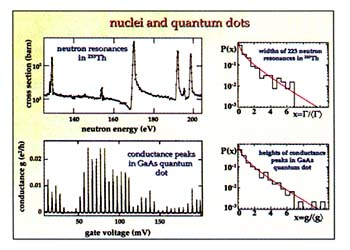 FIGURE 3.4.2 Measured neutron resonances in a compound nucleus 233Th (top) and conductance peaks in GaAs quantum dots (bottom). The presence of peaks in both spectra can be explained in terms of a quantum-mechanical tunneling: whenever the energy of an incoming neutron (electron) matches one of the resonance energies inside a compound nucleus (dot), the probability for capture increases. Distributions P(x) of neutron resonance widths and conductance peak heights are shown on the right. These are well described using the statistical random matrix theory, which gives the same universal probability distribution (red solid line) in both cases. (Courtesy of Yoram Alhassid, Yale University.) |
Nuclear Matter
While heavy and even superheavy nuclei have been discussed above, nature also provides nuclei of virtually infinite size in the dense cores of neutron stars, where hadronic matter exists as a uniform medium, rather than clumped into individual nuclei. Much of what is learned from finite nuclei—the nature of the nucleon-nucleon force, the role of many-nucleon interactions, collective excitations, and so forth—is crucial in explaining the properties of infinite matter. But many new issues, such as matter composed almost entirely of neutrons, have no counterparts in ordinary nuclei.
In the absence of Coulomb forces, the ground state of hadronic matter is a uniform liquid having equal numbers of protons and neutrons. The density of this liquid is about 2.5 × 1014 g/cc or, equivalently, 0.16 nucleons per cubic femtometer. In reality, such a liquid has a prohibitively large Coulomb energy, and thus does not exist. However, nuclei can often be regarded as relatively stable, small drops of cold nuclear matter, and some of their properties can be related to those of uniform nuclear matter.
In the cosmos, extended nuclear matter, having a large excess of neutrons over protons and containing electrons to neutralize the electric charge of the protons, occurs in the interiors of neutron stars, and briefly in massive stars collapsing and then exploding as supernovae. Studies of nuclear matter received a large impetus after the observational discovery of neutron stars in 1968, and the subsequent interest in understanding supernovae.
The dependence of pressure on density and temperature, the equation of state, is one of the most basic properties of matter. At small values of neutron excess (i.e., when the numbers of neutrons and protons are similar), cold nuclear matter is a quantum liquid. It expands on heating, and it undergoes a liquid-gas phase transition with an estimated critical temperature of approximately 18 MeV. In contrast, matter made up of neutrons alone is believed to be a gas even at zero temperature.
The binding energies and density distributions of medium and large nuclei provide information on the equation of state of cold nuclear matter at densities up to its equilibrium density and at values of the neutron-to-proton ratio up to 1.5. Currently available data are inadequate to determine the equation of state of matter with the large neutron excess that is of interest in astrophysics. Hence, extrapolations rely on theoretical predictions of the equation of state of pure neutron matter. In the next decade, a large effort will be made to study the unstable neutron-rich nuclei, using radioactive beams as discussed in the last section. This effort will provide significant additional information.
Nuclei and even large chunks of nuclear matter can undergo global vibrations in which the neutrons move against protons, or, alternatively, neutrons and protons move in unison to produce density and shape oscillations. These vibrations, conceptually similar to the fundamental vibrations of a bell or of a liquid
drop, are called giant resonances. Instead of the sound waves of a bell, they emit gamma rays. These modes can be excited easily by inelastically scattering energetic particles from the nucleus, or by the shock of fusing two nuclei together. The frequencies of these vibrations are directly related to the strength of the restoring forces and to the basic properties of nuclear matter. The simplest mode, the monopole vibration, directly yields the incompressibility of nuclei and by extension of nuclear matter. Such studies have been done for some time on cold nuclei, but such new effects as the compression of the thin skin of nuclei (versus the dense inner core) are still being explored. Recently, it has become possible to excite vibrations in hot nuclei.
The short-range aspects of nuclear structure, related to nuclear forces and binding, are similar in all nuclei, and thus regarded as properties of nuclear matter. They can be studied by using high-energy electrons to knock nucleons and mesons out of nuclei from deep inside the nuclear interior. The coincidence experiments, now starting at the new generation of electron accelerators, will provide exciting new information about nuclear matter. Specifically, it should be possible to refine current understanding about the nature of nucleons bound in nuclear matter. How do they differ from free nucleons? They will also improve our understanding of the boundary between the descriptions of nuclei as bound states of nucleons or quarks. It is known from earlier, noncoincidence experiments that when the electrons are softly scattered, one obtains a relatively successful picture by assuming that they simply knock nucleons out of the nucleus. Whereas for scattering with large loss of energy and momentum, a quark-based picture appears to work. How does one go from one picture to the other? Do the descriptions coexist under some conditions? Future studies with high-energy electrons will help to elucidate these fascinating issues, especially by detecting the specific particles knocked out of the nucleus under conditions where at present only the fact that an electron was scattered is known.
Outlook
The study of the structure of the atomic nucleus provides us with many insights into systems made of many strongly interacting particles. Many features of such systems are well described by amazingly simple models. The way these models emerge from the basic theory of the strong interaction is the subject of continuing study. The coming decade promises substantial progress in our understanding, by extending the study of nuclei into new domains, to the limits of their existence as bound systems. New experimental facilities and the next generation of computers are essential ingredients in this quest.
New facilities to provide exotic short-lived nuclear beams for research will open new opportunities in exploring these limits. Theoretical descriptions of nuclei far from the line of stability suggest that their structure is different from what has been seen in stable nuclei. Nuclei far from stability also play an
important role in the way the universe works and how elements are synthesized in the cosmos. The properties of such nuclei are essential to a quantitative understanding of these processes. Advances in detector technology promise a wealth of new information for nuclear structure studies. New capabilities in electron scattering will provide key information on the short-distance aspects of nuclear structure.
Links in the chain that connect the fundamental theory of strong interactions of quarks and gluons to the properties of actual nuclei need to be better understood. Advances in computer technology and theoretical many-body techniques will make it possible to derive nuclear forces from the dynamics of the quarks and gluons that are confined within nucleons and mesons. New calculations will reveal the links between nuclear forces and effective nuclear interactions acting in complex nuclei. Fundamental questions concerning nuclear dynamics will be answered about the microscopic mechanism governing the large amplitude collective motion, the manifestations of short-range correlations, and the impact of the Pauli exclusion principle on nuclear collective modes. The interdisciplinary character of these studies, common frontiers with condensed matter physics and atomic physics, will be of increasing interest.

